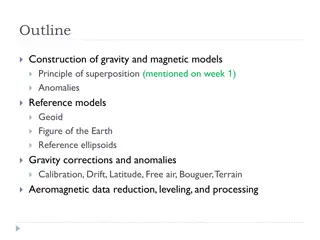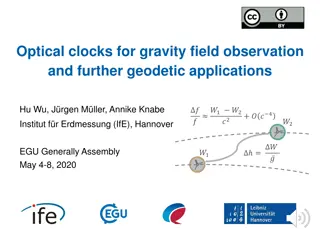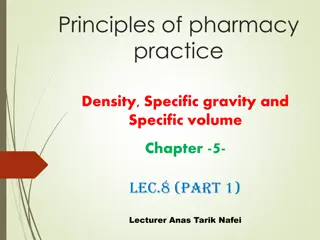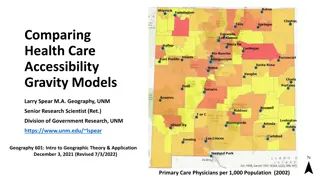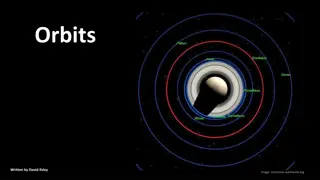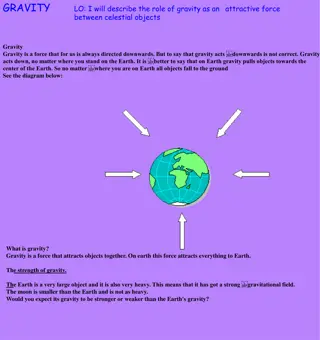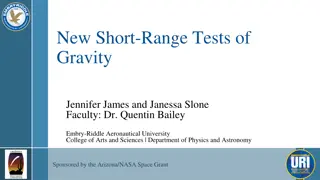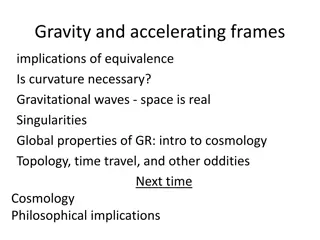Gravity in Space
Discuss the force of gravity, its impact on Earth and space, and how aerospace engineers utilize it. Learn why gravity is crucial in aerospace exploration and its effects on objects in space. Discover how gravity varies in different environments and its significance in space exploration.
Download Presentation

Please find below an Image/Link to download the presentation.
The content on the website is provided AS IS for your information and personal use only. It may not be sold, licensed, or shared on other websites without obtaining consent from the author. Download presentation by click this link. If you encounter any issues during the download, it is possible that the publisher has removed the file from their server.
E N D
Presentation Transcript
YAPA Kids Aerospace Gravity in space
AGENDA Gravity Gravity Gravity in on Earth in space Aerospace 01 02 03 What is gravity? How does it affect us? How is gravity different in space? How do aerospace engineers utilize gravity?
Gravity on Earth Discuss: What do you already know about gravity?
What is gravity? Why does it matter? Gravity is the force that pulls everything toward the center Gravity is the force that keeps us all on Earth. Without it, of Earth. Anything with mass has gravity, and some objects we would be sent flying off into space. This is why when have more gravity than others. For example, the sun has a we jump, we always land back on the ground. While it lot more gravity than Earth. Earth has a gravitational pull of might be fun to float around for a few minutes, we could 9.8 m/s2, meaning all objects fall at the same speed. The not live without gravity. equivalence principle explains this stating, whether the mass is 100 KG or 5 KG, both will fall at a speed of 9.8 m/s2. Gravity was first described by the scientist Isaac Newton. Newton s law of universal gravitation states the greater the mass, the greater the force of attraction. This means that the amount of gravity an object has depends on how heavy it is.
Gravity in SPace Discuss: How do you think gravity might change in space? Is there still gravity in space?
WHat is gravity like in space? Gravity is everywhere, even in space! You may have seen astronauts floating around in aircrafts in space, but those appearances are deceiving as astronauts in orbit are in free fall. They're constantly falling toward Earth, in orbit, but they are moving so fast they miss the ground. Gravity does weaken with distance. The moon (which is 1,000 times farther away than the International Space Station) would not stay in place if it were not pulled by Earth's gravity. Even massive objects such as stars and planets have a tremendous gravitational pull. For example, the sun has such a strong gravitational pull that it keeps Earth, Mars, Saturn, and comets that are over a light year away tethered. The sun, of course, is subject to the gravity of the black hole in the center of the Milky Way. The Milky Way is subject to the gravitational pull of other galaxies nearby. In summary, there is always gravity in space, and it s hard to find an object in space that isn't subject to gravity!
Why is gravity important in Aerospace? Shout out: How do you think aerospace engineers utilize gravity?
GRavitational Assist When planning certain kinds of trajectories of spacecrafts in the solar system, aerospace engineers use a technique called gravitational assist. This may also be referred to as gravity assist, slingshot, or swing by. This technique is used to create a net change in the speed and direction of motion of a spacecraft by passing through the gravitational field of a planet. This technique helps save propellant, time, and expense. This also helps aerospace engineers create spacecrafts such as Voyager 1 and Voyager 2, which travel through space independently and indefinitely.
center of gravity In an airplane, the center of gravity is the point in which the aircraft would balance if it were suspended in the air. This point plays a significant role in ensuring the stability of an aircraft. The location of the center of gravity is dependent on its weight. Usually, the center of gravity (on an airplane) is located in front of the wings. If the center of gravity is too far forward, the airplane will be nose-heavy, meaning it will be difficult to pitch up during takeoff and the ascending climb. If the center of gravity is too far back, the stability will decrease. Some aircrafts are designed with the center of gravity below neutral, but those aircrafts need to be controlled at all times and cannot go on autopilot. Factors that affect the center of gravity include fuel load, passenger weight, cargo weight, and aircraft modifications.
Diving deeper Video link
GRAVITY CLASS QUIZ (don t worry, we ll do this together!)
Thank you!






